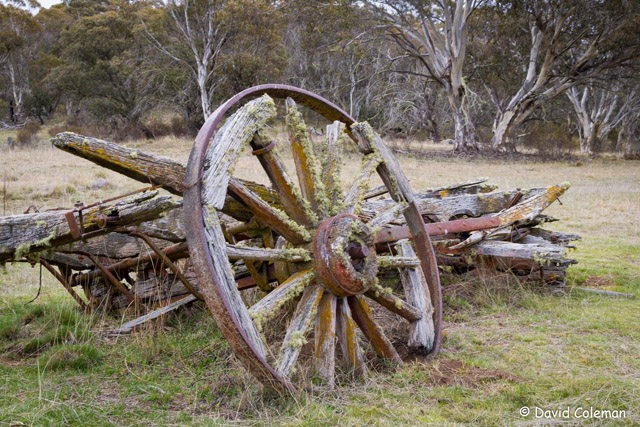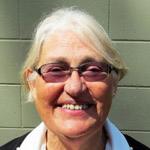
You’ve all seen lichens, like the picture above (photo credit David Coleman, used with permission).
They can be the grey, hairy stuff that grows on the south (in Australia, though I’d prefer to rely on a compass) side of twigs and branches of Eucalypt trees. Or they can be the shiny, blue-grey stuff that forms patches on sheets of granite. Moss can sometimes be mistaken for lichen, although lichen is not usually that green.
Resilient and sensitive
Lichens can be found in many different environments, in all extremes of climate and conditions. In northern parts of the world, lichens provide a food source for caribou and reindeer during the winter months. Lichens have even survived travelling and existing for 18 months in space!
In fact, lichens can also be indicators of pollution, just like frogs and other sensitive macro invertebrate species. They have an ability to concentrate nutrients from dilute sources but in the process they do not discriminate between healthy chemicals and, for example, sulfur compounds that are detrimental to them.
This makes lichens susceptible to air pollution from industrial sources and motor vehicles. There is a discernible diminishing of lichens in the environment the closer you get to urban and industrial areas.
What is lichen?
Lichen is the result of a symbiotic relationship between a fungus and an alga or a cyanobacterium. Symbiosis is a mutually beneficial interaction among organisms, not to be confused with parasitism which usually only benefits the parasite. The fungus provides the structure, or skeleton, of the lichen, but it cannot make its own food. The alga can photosynthesise (make its own food using the energy from sunlight), thus providing another source of nutrients besides absorption from the environment.
A lichen is more than the sum of its parts: taken separately, neither the fungus nor the alga can survive well, but in a symbiotic partnership lichens have structures and make compounds that do not exist when they are separate.
As well as being a source of food for people and animals, lichens have been used to dye cloth and make some medicinal compounds.
So what?
The summary of an article in Scientific American about Trevor Goward, a naturalist who specializes in lichens, makes the statement that “networks may be a more enduring life form than individuals”. This certainly seems true of lichens.
It is also true of many biological relationships in the natural world. Another example is the massive pine trees in Mt Rainier National Park, that grow right up to the edges of cliffs, without falling off or diminishing in stature.
I was intrigued by seeing them and asked a ranger how they managed to stay upright. He answered by describing the network of their roots underground. The reason why the huge pines do not tumble off the edges of cliffs is because their roots are intertwined – forming a network – with those of their neighbours’. They anchor each other in an environment where they wouldn’t survive being by themselves.
Networks – the body of Christ
The metaphysical poet John Donne (1572 – 1631) said “No man is an island, entire of itself; every man is a piece of the continent.” This effectively sums up the human condition.
The Apostle Paul expresses this even better in his first letter to the Corinthians, describing how the body is made up of many parts and each part is vitally necessary to the functioning of the body. Granted, Paul was trying to explain to his readers the importance of the gifts of the Spirit, saying that you can’t take any one gift, or part of the body, in isolation.
We are meant to use our gifts for the strengthening of the church. Implicit in this is the understanding that we need to be in a church – a body of Christ. The gifts are pretty useless to an individual by themselves.
“I’m a Christian but I don’t have to go to church”
No, there is no rule that says you must go to church. But the concept is taken for granted by the writers of the New Testament. Similarly in the Old Testament the nation of Israel lived in community.
How can we love one another if we avoid having contact with one another? It’s in the rubbing shoulders with each other in community that we get our rough edges smoothed out and we may begin to understand people who are different from us.
It is in community that we share suffering and honour. James Chapter 5 verses 13 – 16 assumes a community within which we do life! This version – The Passion Translation – has some interesting insights into such community, if you read the translator’s notes.
Confessing your sins to each other and praying for each other takes courage but is healing for you. This can only happen if you have a network where you can support others and they can support you.
Worried about decisions to be made? Proverbs Chapter 15 verse 22 advocates seeking many counselors in making decisions.
Ultimately, the biggest lesson we can learn from lichen is that in the community of a church, we are greater than as individuals. In a network we help each other, we grow, we warn each other of danger and we are stronger than we are as individuals.
 Aira Chilcott is a retired secondary school teacher with lots of science and theology under her belt. Aira is a panellist for Young Writers and indulges in reading, bushwalking, volunteering at a nature reserve and learning to play clarinet. Aira is married to Bill and they have three adult sons.
Aira Chilcott is a retired secondary school teacher with lots of science and theology under her belt. Aira is a panellist for Young Writers and indulges in reading, bushwalking, volunteering at a nature reserve and learning to play clarinet. Aira is married to Bill and they have three adult sons.
Aira Chilcott's previous articles may be viewed at http://www.pressserviceinternational.org/aira-chilcott.html

Aira Chilcott is a retired secondary school teacher with lots of science andtheology under her belt. Aira is an editor for PSI and indulges inreading, bushwalking and volunteering at a nature reserve. Aira’s husband Bill passed away in 2022 and she is left with three wonderful adult sons and one grandson.
Aira Chilcott's previous articles may be viewed at http://www.pressserviceinternational.org/aira-chilcott.html